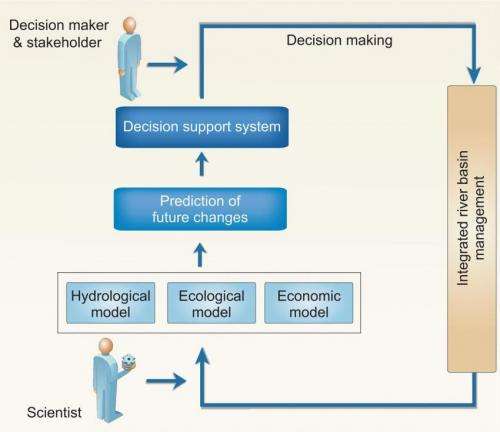Diverting a river from ecological disaster in northwestern China could provide new sustainable model

Population expansions and high-speed economic development along major rivers have triggered ecological disasters across the world. In northwestern China, a massive water diversion project helped rescue the Heihe River and reverse environmental damage. Integrated management of the river ecosystem and the economy, and measures aimed at protecting the entire river basin, outlined in a new study by Chinese scientists, could provide a model for saving rivers in other parts of China and worldwide.
For tens of thousands of years, modern humans have used the waterways to spread out across the surface of the planet. Major civilizations developed along massive rivers like the Nile in Egypt and the Yellow River in China, and massive water channels propelled the expansion of economies around the world. But in recent decades, according to a team of scientists at the Cold and Arid Regions Environmental and Engineering Research Institute, Chinese Academy of Sciences, in the northwestern Chinese city of Lanzhou, the competition between economic growth and the ecosystem of rivers has triggered a series of environmental crises around the world. In northwestern China, they write in a new study, "many of the inland river basins ... have experienced a common challenge."
"With the population booming and the rapid economic development in the up- and mid- stream areas of the river basins, the consumption of water increases dramatically and diminishes the water available for ecological processes," they state in an article published in the Beijing-based journal National Science Review.
"The terminal lakes dry up, sandstorms become more common and the Populus euphratica forests die, causing a series of severe ecological disasters," add Professor Guodong Cheng and co-authors of the new study, "Integrated study of the water-ecosystem-economy in the Heihe River Basin."
Around the turn of the century, an ecological water diversion project involving the Heihe was implemented under the management of the central government of China. As a result, the severe deterioration of ecosystems in the downstream areas of the Heihe River Basin has been reversed to a great degree.
Studies on the water, atmosphere, ecology and anthropogenic activities along the Heihe have built a foundation for supporting the sustainable development of other inland river basins. In their new article, Professor Cheng and co-authors review integrated studies of the water-ecosystem-economy of the Heihe River as a potential model for the sustainable development of other inland river basins.
They present an array of findings:
1. The river basin must be viewed and managed in its entirety in order to coordinate water resources utilization, ecological health and economic development.
2. Decision support systems based on integrated watershed models are useful tools for managing water resources.
3. Integrated studies of the river's ecosystem and the related economy in the Heihe Basin can serve as a model to guide sustainable development strategies developed for other inland river basins.
The population boom and rapid economic development that triggered environmental disasters along the Heihe River also impact other rivers in China and worldwide.
The competition for water between the economy and the ecosystem is intensifying all over the world. The solution to this looming crisis must involve the careful and rational use of limited water resources in ways that not only support economic development but also sustain the health of the ecosystems.
The Heihe is a typical inland river basin, located in arid region of northwest China, and has become an experimental testing ground to carry out integrated studies of the ecosystem and economy.
Scientific research has been playing a key role in supporting ecosystem rehabilitation along the Heihe River Basin.
Since an ecological water diversion project was launched in 2000, severe deterioration of ecosystems in the downstream areas of the Heihe has been greatly alleviated.
However, there have also been negative effects on groundwater depth and the regional woodlands, and managing overall water resources is still a big challenge.
Emerging sciences such as ecological economics and ecohydrology have been introduced as new research directions in the integrated study of the river.
Eco-hydrological studies focus on improving the output per cubic meter of water. Eco-economic studies focus on coordinating ecosystem health and economic development.
The co-authors of the study propose that an evaluation of environmental losses and ecosystem service should be introduced into the national economic accounting system.
They also state that despite the initial successes of the Heihe diversion project, conflicts between the demands of economic growth and those of the ecosystem, and among different regions of the river basin, still present challenges.
An integrated platform that incorporates monitoring, modeling and data manipulation has been developed to support integrated study of the Heihe. Integrated models have been used to understand complex interactions within the "water-soil-air-plant-human" continuum.
Future work should focus on developing an increasingly sophisticated solution to balance the interests of the water ecosystem and economic development that incorporates scientific findings and models to support sustainable development of the river basin.
Advances made in reversing ecological harm along the Heihe River Basin can be used to guide ecological progress and socioeconomic development of other inland river basins.
More information: Guodong Cheng, Xin Li, Wenzhi Zhao, Zhongmin Xu, Qi Feng, Shengchun Xiao SC, Honglang Xiao , Integrated study of the water-ecosystem-economy in the Heihe River Basin. National Science Review, 2014, 1(3): 413-428. nsr.oxfordjournals.org/content/1/3/413.full
Provided by Science China Press

















